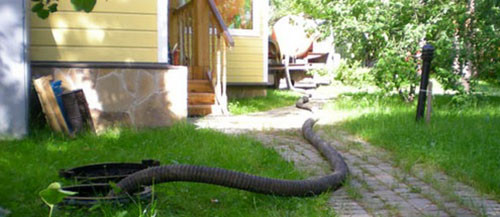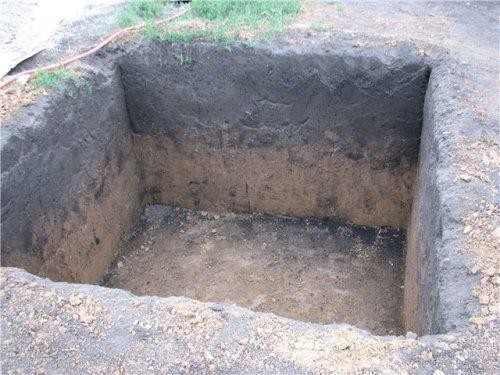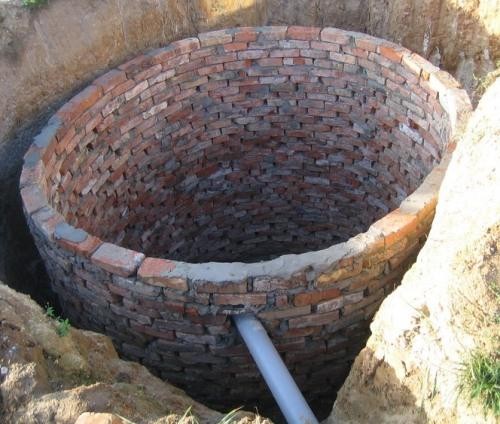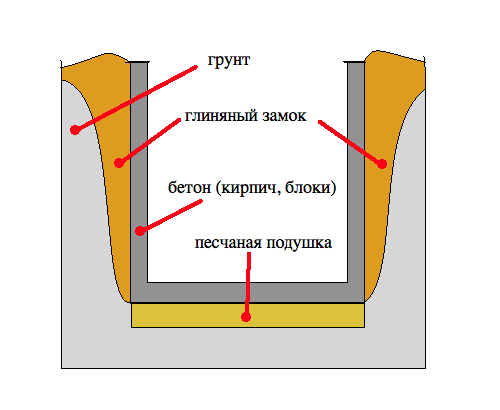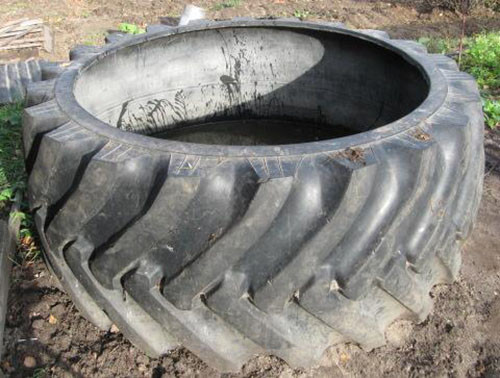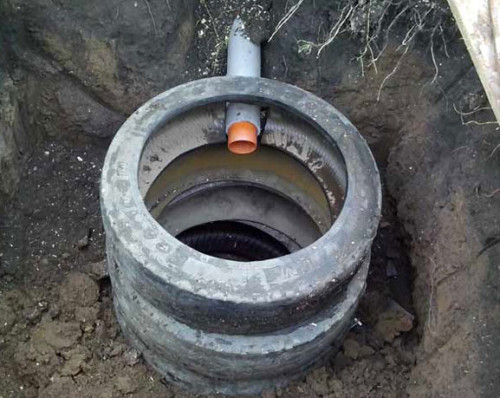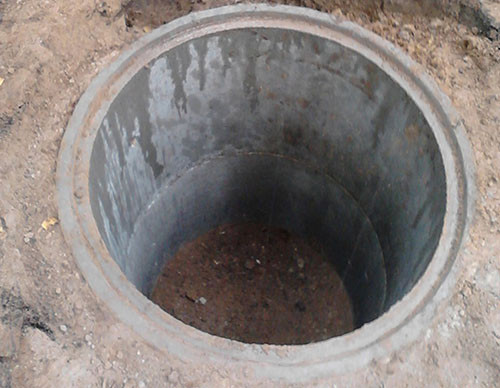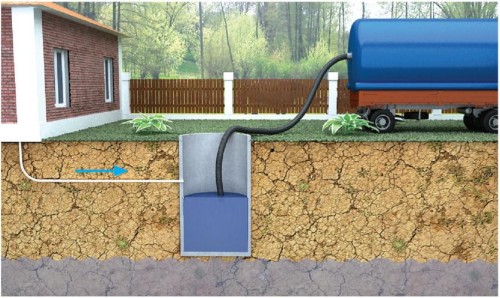
Toilet pit: requirements and norms Plumbing,Plot.
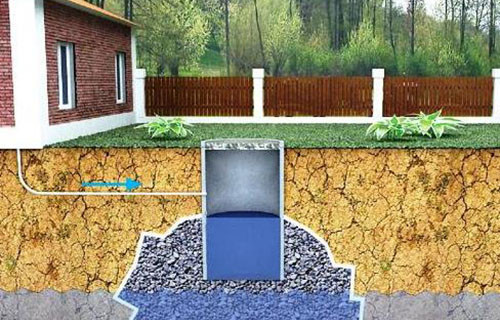
At every summer cottage, there should be convenience, even if the owners come there rarely and briefly, not to mention the seasonal accommodation. The gasket of full-fledged sewering task is very troublesome, but what to say is useful, but at first you can limit the toilet on the street. The design of the country toilet in most cases provides for the construction of a cesspool. If one or two people live in the house, you can restrict ourselves to a relay or a backlash, in the rest of the same cases, without a pit can not do. In this article we will tell you everything you need to know about cesspools for the toilet.
Content
Where to begin?
The main task of cesspools is to localize wastewater, followed by their removal or decomposition. In the first case, this happens with the help of the assessing agents, in the second - biological preparations (bacteria). The cesspool is a great recess (about 2 m) in the ground of a rectangular or round form. The walls and bottom of the recess can be laid out with various materials: brick, concrete, blocks.
Choosing a place
There are certain sanitary standards that need to be guided by choosing the location of the cesspool on the site. First of all, it should be not far from the fence or in the fast accessibility of the assessing machine (if such a way of emptying is assumed). It is best to escape the pit in the angular part of the site.
The standards for the placement of cesspools according to SNiP:
- The pit must be at least 12 meters from the residential building.
- There should be no less than 1 m between the pit and the fence.
- Between the pit and trees should withstand a minimum distance of 4 m, for bushes it is reduced to 2 m.
- There should be about 4 meters between the cesspool and economic buildings (this also applies to the buildings that contain animals).
- The pit should be located at least 30 meters from any water source, be it a well, pond or lake. Build cesspools without bottoming near any reservoirs is prohibited.
It should be borne in mind that if you planned to dig a hole in the corner of the meter from the fence, and on the back of it is a neighborous residential building or a large tree, the distance between the pit and the fence should be increased to 12 m or 4 m, respectively.
Calculation of volume
The volume of the cesspool of the dacha toilet should be made with regard to several factors. The fundamental is the number of people permanently residing on the site and consumption by water.
Consider the factors affecting the calculation of the volume:
- Permanent residents - the average daily rate of water consumption by an adult man is about 150-180 liters. At first glance it seems that it is too much, but there are averaged indicators. At the same time, the pit should always be done with a small margin in the case of the arrival of guests or unforeseen circumstances.
- The characteristics of the soil - if the site is located on the ground, well-transmitting water, the volume of the pits can be only 40% of the entire flow for the month. If the soil is solid or clay, that is, poorly absorbs water, the volume should be made with a margin. Naturally, this factor affects the calculation of pits with a drainage bottom (without the bottom).
- In the depths of the pit, it can be not more than 3 m, otherwise it will not work well. This applies to hermetic structures. But the septicch can reach in a depth of more than 3 m, since in this case natural purification will occur.
Important: If the groundwater on your site is closer to the surface (above 2.5 m), there will have to refuse to dig a cesspool, or make it completely shallow.
Types of cesspools
We distinguish hermetic cesspools and designs without the bottom. Of course, the bottom of them has, only it, unlike hermetic, plays the role of a filter, holding down the large-membered particles and passing into the ground only liquid. Below we briefly consider the technology of building cesspools from various materials.
Brick Yama
One of the most popular ways to build a pit for a street toilet with their own hands. Brick is relatively inexpensive, and you can learn how to make high-quality masonry can be pretty quickly.
To create a hermetic (overhaul) cesspool pockets from the brick, they first rotate the pit, then align its bottom and fall asleep with sand and crushed stone layer with a thickness of 20-30 cm. Carefully ramming such a drainage pillow, tops the steel grid for reinforcement and poured concrete. When the screed dry, lay the brick walls on the cement solution and wake them from the inside with a bitumen mastic so that the sewage is not leaked into the ground.
Instead of bricks, you can use slag blocks or other block materials that are resistant to the destructive effects of moisture and strong enough to stay in the Earth at least 10 years. The video below shows the process of building a pit-septicity for the toilet in the country:
The pit with a filtration room is more simple, since the bottom of the pit is covered only with drainage from sand and crushed stone without reinforcement and subsequent screed. The masonry of the brick walls occurs according to the technology in the gallery with dressing. The stability of such a design is worse than in the previous case, however, the cost is somewhat less.
Before you decide on the construction of a "bottomless" pit, some restrictions should be taken into account:
- The pit without the bottom can not be built at a shallow groundwater occurrence.
- If the daily sewage volume exceeds 1 m³, the pit will not cope with the load.
- If within a radius of 50 m there are reservoirs.
Useful advice: If nothing prevents the construction of a brick pit, instead of ordinary blocks, use semi-blocks - so you will save a decent amount. After the construction of the walls, the space between the outer side of the masonry and the earthen wall of the pit should fill the clay so that the so-called clay castle turns out (see Figure below).
A pits with a filtration bottom has obvious advantages compared to hermetic. So, due to the natural outflow of fluid to the ground, it is necessary to use the services of the assessing agents so often. It serves as a design for quite a long time - 20-25 years with proper care, and repair does not deliver special hassle (it will only be necessary to replace the masonry in the right places and re-covered with waterproofing). Wastewood is distributed evenly, therefore the risk of soil contamination is minimal. The only serious disadvantage of the pit without the bottom is the periodic dragging and the need for regular cleaning. Fortunately, special biological products that we will tell about it are helping to cope with this.
Pit from tires
Oddly enough, a functional cesspool can be made from old and no one for the necessary automotive tires. On the one hand, the optimal option for economical owners, on the other - such a pit is not suitable for everyone. The design of tires is relevant only for small amounts of wastewater, for example, if 1-2 people live in the country seasonally.
The advantages of such a decision are obvious:
- the design is easy to install;
- the cost of work is minimal (the cost of sealant and pipes);
- you can build such a pit per day.
Good news: For the construction of such a pit, any tires can be used, including from trucks (diameter greater than 1 m allows you to increase the volume).
Unfortunately, without lack of anywhere:
- a pit from tire will serve no more than 15 years;
- the risk of tightness disorders due to soil movement;
- you can build such a pit at a minimum of 30 m from any water sources (not every site is so great);
- the risk of unpleasant odor with time;
- it is difficult to repair and dismantle.
If the above warnings are not frightened, we suggest familiarizing yourself with the step-by-step instructions for the construction of pits from automotive tires.
Highlights of work:
- The amount of tires and their size depends on the desired volume of the cesspool. The optimal option is 10 pieces of medium size. Get the old tires are easy (do not try to buy new!) - Come on the auto repair shop and one hundred.
- Put one tire to the place where the future pit will be located, and outline the shovel circumference to designate the dimensions of the pit.
- Drop the deepening of the calculated value by making the bottom under a slight tilt to the landing site of the hatch - it will be easier to empty the pit.
- In the center of the pit, drill a drainage well with the Garden Bura. The well will freely skip wastewater through solid soil layers and will not allow them to be stamped.
- Insert the drainage tube of such a length from a drinker so that its upper end climbs over the bottom to 1 m. It is necessary that only liquid falls into the pipe, but not solid particles that can score it. On the sides of the pipe, drill a lot of holes to drill so that the drainage flows continuously and freely. To protect the holes from the bed, wrap the pipe with a polypropylene network, capturing and upper cut.
- At the bottom of the pits, pour 10 cm layer with a small rubbank.
- Start laying out the car tires, having pre-cut from each inner rim. This will allow water to fire freely and not linger inside the tires.
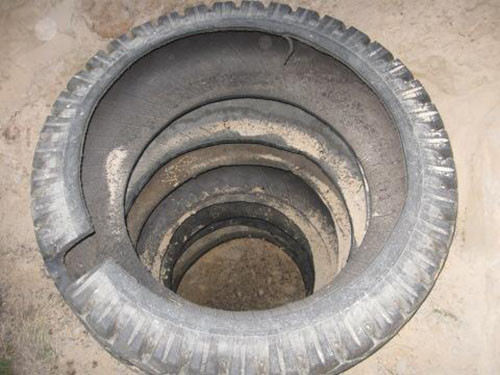
- Install the introductory tube, cutting the hole of the corresponding diameter on the sidewall of the tires.
- Place the tires so that the latter is slightly towered above the ground level (10-15 cm).
- The remaining distance between the external walls of the tires and the pit can be filled with unnecessary tires or to build a clay castle, after which it is soaked.

- Internal junctions between tires should be seal with sealant.
- The top of the obtained cesspool should be closed with a hatch or build a toilet house from above.
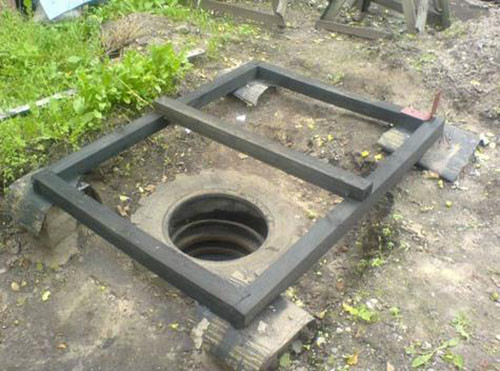
For full ventilation, in order to avoid the appearance of unpleasant odors, inhibit the ventilation pipe so that it rises from the pit no less than 1 m (ideally the pipe is better to raise higher, so that the smells immediately went up, and not remained at the level of human growth).
Maja of concrete rings
In the presence of large lifting equipment, build a cesspool from concrete rings is easier than simple. The expended means and forces are fully justified at least the fact that the concrete pit serves as long as the brick and the more made of the tires.
Concrete cesspool construction technology:
- The bottom of the dug pit is done under a slight bias towards the hatch, after which they are torn and fall asleep 15 cm layer of sand.
- Sands are abundantly watered with water to catch, then pour a 15 cm layer of rubble or gravel.
- On top of this drainage pillow, the reinforcing grid is placed, a slightly setting it on the walls of the pit.
- Pullen a concrete screed with a thickness of 10 cm and leave it to complete drying (for 3-5 days depending on the weather).
- Alternately omit on the bottom of the rings, immediately customizing the top ring with the previous one.

- After installation, the internal joints between the rings are wedged with concrete solution, the external - covered with bitumen mastic. Ideally, bitumen should be deceived all the external rings.
- Install the overlap with the hatch. The overlap can be made of concrete, boards or specifically bought at the same factory where rings are produced.
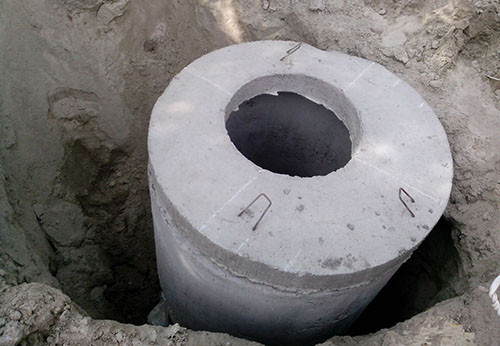
By the way, today you can buy even special plates (ready-made ties) installed on the bottom of cesspool wells. Such slabs are both hermetic and perforated to create filtering holes.
Cleaning and care for the pit
So that the cesspool served longer and did not cause problems, you need to immediately teach yourself to care for her. First of all, to find out the phone of the assessing agents and explore the range of biological preparations for septics. Ideally, it is necessary to call an arbor car once a year, but this is only if the pit works equally stably and properly. In fact, such luck can boast units.
The intensity of any cesspool will deteriorate over time, but it happens so gradually that at first it remains unnoticed, and then some problem immediately pops up: a blockage, casing, unpleasant smell, disruption of tightness, etc. To prevent this, it is necessary to clean cesspool and toilets from time to time. For this, many of the habit are aroused by the assessing agents, forgetting the existence of biologically active drugs.
Application of biological products
Biopreparations for cesspools and toilets operate in a very interesting way. In fact, this is a plurality of microscopic bacteria, which in a short time split solid particles of uncleanness, turning them into a liquid and absolutely safe substance from an ecological point of view. The products of human vital activity and a dead organist are food for these bacteria, so they not only quickly recycled everything that has time to drain in the pit recently, but also eliminate all blockages, cleaning the sewer system.
Features of the use of biological preparations for cesspools and toilets:
- Bacteria split not only fecal masses, but also paper, plant cleaning and any other organic, as a result of which the amount of waste decreases.
- Biopreparations are completely harmless to materials from which cesspools are made, be it brick, concrete, rubber or plastic.
- Bacteria are powered only by organic, so do not wash off in the toilet or throw household and construction trash into the pit, including glass bottles and polyethylene.
- Bacteria - live, although extremely small creatures, so contact with chemicals can be destructive for them. If the drains contain chemistry (chlorine, detergents), bacteria will die.
- The bacterial agent for cesspools and toilets begins to act 1.5-2 hours after entering into a liquid medium. The first is the unpleasant smell (after 4 hours), and this is evidence of successful work.
- No one is engaged in the biochist of cesspool, because bacteria behave actively only in the temperature range from + 5C to + 30s.
Before making a biopreparation, carefully read the instructions (not all of them act equally). So, there is a liquid for toilets and cesspool, which can be immediately poured into a septic, and there are granules or powder, which first need to be dissolved in heat water.
Country toilet without a pit is a deplorable sight, so the construction of the construction is needed from the first days of the acquisition of the site. We hope this article will allow you to choose the most appropriate version of the pit and implement the smallest conceived.




